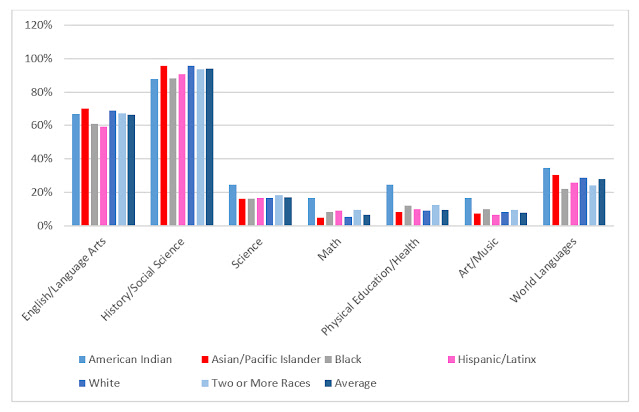Take Two: Students Primarily Experience Civic Learning Opportunities in Social Science and English Courses at Democracy Schools; Cross-Curricular Applications Abound
by Shawn P. Healy, PhD, Democracy Program Director
In March, the tenth annual convening of the Illinois Democracy Schools Network was canceled with the onset of the COVID-19 pandemic. In its place, the Network is sponsoring a webinar series titled, “Every Teacher is a Civics Teacher: Best Practices for Civic Learning and Organizational Supports in Schools.” The series kicks off on Thursday, December 3rd at 4pm by exploring the intersections of civic learning, vision and leadership, and school climate. Subsequent sessions will take place on the first and third Thursdays of each month from January through April, each from 4-5pm, and feature civic learning innovations among Democracy Schools and partner organizations.
In the spirit of the webinar series, this post analyzes student data gathering during the 2019-2020 school year by 17 current and prospective Democracy Schools with emphasis on cross-curricular integration of civic learning (also see my March 2020 analysis of data from the 2018-2019 cohort).
Civic learning’s natural home is the social sciences and 94.2% of students surveyed said they learned about civics content in these courses, but English also ranks perennially high, with nearly 66.6% of students experiencing civics content here, too (see Figure 1 below). The drop-off in other subject areas is steep, with nearly three-in-ten students identifying civics content in world language courses (27.8%) and 17.0% in science courses, but less than ten percent of art/music (8.0%), physical education (9.6%), and math (6.7%) classes included civics content. There is limited variation in exposure to civics content by students’ race/ethnicity, although Black and Latinx students reported below average exposure in social science and English courses, the category leaders.
Figure 1: In which classes have you learned about civics content (i.e, the US system of government and how it works)?
The data broke down similarly in measuring other proven civic learning practices across the curriculum, including discussions of current and controversial issues, civic role-playing activities, and service learning, with a majority of students experiencing these practices in the social sciences (83.4%, 76.6%, and 62.8%, respectively), but among other subjects, only English/Language Arts demonstrated a majority for controversial issues discussions (67.8%). Moreover, there is evidence of a civic opportunity gap for Black and Latinx students when it comes to controversial issues discussions in social science and ELA classes and civic role-playing in social science courses. Latinx students also experienced fewer civic role-playing opportunities in ELA classes (see Figure 2 below).
Figure 2: In which classes did you participate in civic role-playing activities (i.e., political leader or politician)?
In sum, there are numerous opportunities for Democracy Schools to further integrate civic learning opportunities across the curriculum, particularly beyond social science and English. Given that the latter two subjects offer the bulk of current civic learning opportunities, teachers and schools should also make stronger commitments to ensure they are offered equitably to students of all races and ethnicities. And schools statewide should adopt the mantra that students’ civic development is not the sole responsibility of the social studies.






Comments
Post a Comment